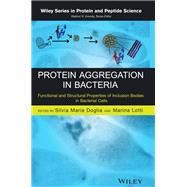
Protein Aggregation in Bacteria Functional and Structural Properties of Inclusion Bodies in Bacterial Cells
by Doglia, Silvia Maria; Lotti, MarinaBuy New
Rent Textbook
Rent Digital
Used Textbook
We're Sorry
Sold Out
How Marketplace Works:
- This item is offered by an independent seller and not shipped from our warehouse
- Item details like edition and cover design may differ from our description; see seller's comments before ordering.
- Sellers much confirm and ship within two business days; otherwise, the order will be cancelled and refunded.
- Marketplace purchases cannot be returned to eCampus.com. Contact the seller directly for inquiries; if no response within two days, contact customer service.
- Additional shipping costs apply to Marketplace purchases. Review shipping costs at checkout.
Summary
The following topics are addressed: a) molecular and cellular mechanisms of protein folding, aggregation
and disaggregation in bacteria; b) physiological importance and consequences of aggregation for the bacterial cell; c) factors inherent to the protein sequence responsible for aggregation and evolutionary mechanisms to keep proteins soluble; d) structural properties of proteins expressed as soluble aggregates and as inclusion bodies within bacterial cells both from a methodological point of view and with regard to their similarity with amyloids; e) control of the structural and functional properties of aggregated proteins and use thereof in biotechnology and medicine.
Author Biography
SILVIA MARIA DOGLIA, PhD, is Professor of Physics at the University of Milano-Bicocca, Italy. She received her Laurea degree in Physics at the University of Milano. She has been Staff Research Scientist of the Italian National Research Council; Visiting Scientist at the University of Stockholm; Visiting Professor at the Universities of Orléans (Fr) and of Reims (Fr). Her research in Biophysics at the University of Milano-Bicocca is focused on the study of protein folding and aggregation in vitro and in situ.
MARINA LOTTI, PhD, is Professor of Biochemistry at the University of Milano-Bicocca, Italy, where she leads the group Protein Engineering and Industrial Enzymology, and is the Head of the Department of Biotechnology and Biosciences. She obtained her PhD degree at the Max-Planck Institute of Molecular Genetics, Berlin, and was a researcher of the Italian National Research Council. Major research topics include the production of recombinant proteins, protein aggregation, cold-active enzymes, and intrinsically disordered proteins.
Table of Contents
Contributors vii
Preface xi
Introduction to the Wiley Series in Protein and Peptide Science xiii
1 Fundamentals of Protein Folding 1
Vladimir N. Uversky
2 Recruiting Unfolding Chaperones to Solubilize Misfolded Recombinant Proteins 63
Rayees U.H. Mattoo and Pierre Goloubinoff
3 Osmolytes as Chemical Chaperones to Use in Protein Biotechnology 77
Ario de Marco
4 Inclusion Bodies in the Study of Amyloid Aggregation 93
Anna Villar-Piqué and Salvador Ventura
5 Protein Aggregation in Unicellular Eukaryotes 117
Marina Caldara, Joris Winderickx, and Vanessa Franssens
6 Structural Properties of Bacterial Inclusion Bodies 151
Antonino Natalello, Diletta Ami, and Silvia Maria Doglia
7 Residue-Specific Structural Studies of Inclusion Bodies 181
Christian Wasmer, Marielle Wälti, Yongli Chen, and Lei Wang
8 Biomedical Applications of Bacterial Inclusion Bodies 203
Imma Ratera, Spela Peternel, Joaquin Seras-Franzoso, Olivia Cano-Garrido, Elena García-Fruitós, Rafael Cubarsí, Esther Vazquez, José Luis Corchero, Escarlata Rodríguez-Carmona, Jaume Veciana, and Antonio Villaverde
9 Aggregation of Recombinant Proteins: Understanding Basic Issues to Overcome Production Bottlenecks 221
Marina Lotti and Loredano Pollegioni
10 Fusion to a Pull-Down Module: Designing Enzymes to Form Biocatalytically Active Insoluble Aggregates 247
Bernd Nidetzky
Index 263
An electronic version of this book is available through VitalSource.
This book is viewable on PC, Mac, iPhone, iPad, iPod Touch, and most smartphones.
By purchasing, you will be able to view this book online, as well as download it, for the chosen number of days.
Digital License
You are licensing a digital product for a set duration. Durations are set forth in the product description, with "Lifetime" typically meaning five (5) years of online access and permanent download to a supported device. All licenses are non-transferable.
More details can be found here.
A downloadable version of this book is available through the eCampus Reader or compatible Adobe readers.
Applications are available on iOS, Android, PC, Mac, and Windows Mobile platforms.
Please view the compatibility matrix prior to purchase.
